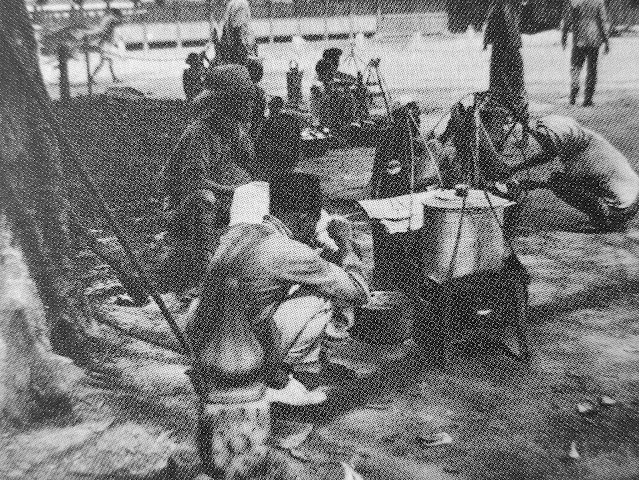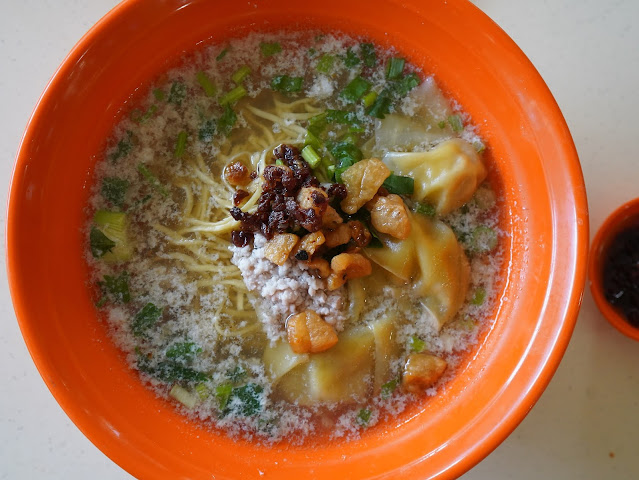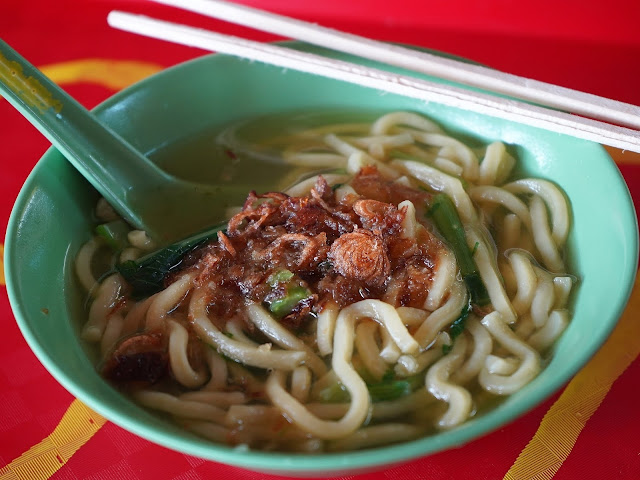Growing up in 1960s Singapore, I was fortunate to see the last legs of Singapore's two-basket hawkers before they disappeared.
As a child living on the eighth floor of a public housing flat in Singapore (unit #378-G, block 65, Lorong 5, Toa Payoh), one of my pastimes was to look out of the window at the goings on below. We had no television or other distractions then. (Image courtesy of NAS.)
In the afternoons, a Malay hawker selling mee rebus would come to the bottom of the flat. He would park his two baskets and bamboo pole at the open space between blocks 65 and 67, and wait for his customers.
In one pot was golden mee rebus sauce simmering in a pot on a charcoal stove. In the other basket was a pot of boiling water on a charcoal stove for cooking noodles and bean sprouts. Somewhere in the baskets were drawers with yellow noodles and bean sprouts inside.
I don't remember the mee rebus man calling out or making any sound to announce his presence. It was not necessary. From my eighth floor flat, I could smell the aroma coming from his pot of mee rebus sauce.
Today, I sometimes joked that I couldn't smell anything from the mee rebus right under my nose. Most of my sense of smell must have left me 😂
Two-basket hawkers carry their kitchen (pots and charcoal stoves), pantry (food ingredients, cutlery, utensils), and kitchen sink (washing pail) across their shoulders on a bamboo pole.
The hawkers plied their trade walking the streets, often shirtless and bare foot. They wore short pants or baggy trousers and sometimes a hat to shield them from the sun.
Customers ate standing, squatting or sat on any comfortable surface they could find.
Where a few two-basket hawkers parked their stalls together, the spot became a foodie haven, the precursor of today's hawker centre.
Two-basket Indian coffee hawker in the 1890s - it was quite a while before the first Hainanese kopitiam appeared around the 1930s. (Image courtesy of NAS.)
Such a bare bones, rudimentary set up dictated that dishes from two-basket hawkers were simple by necessity, often one bowl meals.
Tan Chee Kok came to Singapore from Chaoshan in Guangdong province in 1921. He was a Teochew beef noodle seller in his hometown and when he arrived in Singapore, he first plied his trade on two baskets and a bamboo pole walking around Anglo-Chinese School at Fort Canning Rise.
Today, Hock Lam Street Beef Noodle is in its third and fourth generations. The dish has been beefed up (pun intended) from its humbler days of just beef soup, kway teow (flat rice noodles) and beef slices.
陈联福 came to Singapore in the 1920s from Chaozhou city in China's Guangdong province. He sold bak chor mee or minced pork noodles as a two-basket hawker around the Chai Chee area in the east of Singapore. The two baskets were such a strain on his back that 陈联福 became hunched. His famous two-basket noodle stall became known as "Hunchback noodles".
陈联福's bak chor mee consisted of pork bone soup, blanched minced pork, minced pork wanton and noodles - that's all. Fish sauce, lard crouton and deep fried shallot added more flavours and aromas to the simple dish.
Today, there are 11 bak chor mee stalls that trace their roots to 陈联福 but most sell contemporary versions with more ingredients like fish balls, pork balls, etc. Famous Eunos BCM Bak Chor Mee stall still sells the original 陈联福 bak chor mee. I enjoyed this humble version as heritage tastes like another layer of flavour to me.
During its heyday (before the advent of pedal trishaws in the 1930s), there were some 30,000 hand pulled rickshaws plying the streets of Singapore. Rickshaw pullers were fuelled by rickshaw noodles sold by two-basket hawkers.
(I love this fascinating speechless video of 1920s Hock Lam Street. We can see rickshaw pullers and one of them eating at a two-basket hawker stall, probably serving rickshaw noodles.)
Like other two-basket hawker fare, rickshaw noodle is a humble dish. It is chai sim vegetable soup flavoured with dried shrimps which give it a savoury sweet taste and blanched yellow noodles - that's all. Deep fried shallot add flavour and aroma to the simple staple. In the old days, the noodles were snipped into short strands so that they can be eaten with just a spoon or slurped directly into the mouth.
Only a couple of stalls in Singapore still serve this dish. One of them is at Maxwell Road Food Centre.
In Singapore, laksa is synonymous with Katong laksa or Janggut laksa. In Singapore, Nyonya laksa was originally cooked only in Peranakan households. The recipe of Peranakan dishes were jealously guarded. As wealthy Peranakan households often employed Hainanese as cooks, the once secret recipes became known outside the family.
Ng Juat Swee better known as Janggut (Malay for "the bearded one") learnt the laksa recipe from a Hainanese two-basket hawker selling Nyonya laksa in Katong in the 1950s. Soon, Janggut too sold Nyonya laksa plying the streets of Katong with two baskets on a bamboo pole.
Nyonya laksa is coconut milk flavoured with hot and aromatic spices, dried shrimps etc., and eaten with thick round rice noodles. The dish is garnished with aromatic chopped "laksa leaves". The noodles are cut into short strands so that it can be eaten with just a spoon (similar idea as rickshaw noodles).
Janggut's descendants still run Nyonya laksa stalls such as at Roxy Square shopping centre and Queensway shopping centre. There are also famous spinoffs like 328 Katong Laksa and George Laksa.
What other two-basket hawker dishes can you think of and where can we get it now in Singapore?
Today, our hawkers are better housed, better equipped and relatively well resourced. Contemporary versions of heritage dishes that have their roots as two-basket hawker dishes now come with more and better ingredients, bigger servings etc.
I am glad that some of these humble dishes are still sold in its original form as these are historical artefacts just like conservation buildings, monuments and historic sites.
A satay date in 1950s Singapore. (Image courtesy of NAS.)
Please share your memories of two-basket hawkers in the comments.
Epilogue: Two-basket hawkers gradually "upgraded" to wheeled stalls and fixed food stalls. By the mid-1980s, all street hawkers in Singapore, two-basket or wheeled were all housed in over 100 hawker centres.
Date: 31 Oct 2020

















I remember mine was a ah Ma selling char mee, char bihun, CCF & yam cake. She would carry the 2 baskets of these goodies and sell at my 8th floor . Lift then will only stops at 1st, 4th & 8th floor of the 10th story flat at Bendemeer rd.
ReplyDeleteWe would bring our own plate to buy fm her ... favourite is the char mee till today ... with sweet red sauce & little bit of chilli sauce & a few green chillies.
Fondly remember the deep fried soya bean strips place on top of the noodles.
Memories aar ��
oh yes, those old time fried noodles and bee hoon. so simple yet so delicious. those crackly fried soya bean strips. I haven't seen them for a while! thanks for the memories :-D
DeleteI lived in Petaling Garden (Petaling Jaya, Selangor) in the 1970s. It was the first housing estate in PJ and built in the early 1960s. I fondly remember the Indian hawker, wearing his dhoti, selling nyonya kuih who would come every morning, carrying 2 enormous Tiffin carriers balanced on a pole. Each Tiffin tray held different types of kuihs. Later in the morning, a tricycle hawker stall selling wanton noodles would make its rounds. We used to hail it and bring our own bowls for the noodles. Then, over the day, we have other wheeled hawkers selling ice cream (Magnolia), curry mee, fried noodles, and others. In the evenings, a hawker stall selling hot dogs and hamburgers would make its rounds, ran by two young men who had failed their MCE (Form 5 Malaysia Cambridge Examinations) but were entrepreneurial enough to set up their own business and did very well. Good old days when food came to you at your doorstep!
ReplyDeleteI lived in Petaling Garden (in Petaling Jaya, Selangor) in the 1970s. It was the first housing estate in PJ and was built in the early 1960s. I fondly remember the Indian hawker selling nyonya kuih who would go around every morning, carrying 2 enormous Tiffin carriers balanced on a pole. Each Tiffin tray held different types of kuihs. Later in the morning, a tricycle hawker stall selling wanton noodles would make its rounds. We used to hail it and bring our own bowls for the noodles. Then, over the day, we have other wheeled hawkers selling ice cream (Magnolia), curry mee, and others. In the evenings, a hawker stall selling hot dogs and hamburgers would make its rounds, ran by two young men who had failed their MCE (form 5 Malaysia Cambridge Examinations) but were entrepreneurial enough to set up their own business. Good old days when food came to you at your doorstep!
ReplyDeleteDear Chew, Thank you for your interesting insights. Appreciate much :-D
DeleteOur Snacks time when we were in our Primary School days in 1960's were those hawkers that were in the two baskets meals from Laksa. Satay, Kuehs, Noodles that were fried before hand and many Indian and Malay meals in the Queenstown estate where I grew up. Your article brought of memories that fly by me reading your article. Thank you for the beautiful days gone by
ReplyDelete